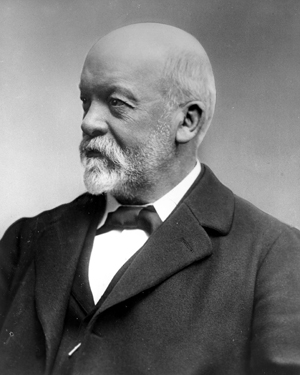 Gottlieb Daimler (1834-1900) was the inventor of the compact, high-speed combustion engine and one of the founding fathers of the present-day Daimler AG, the world’s oldest automotive manufacturer. He was born in 1834, the son of a master baker in Schorndorf, a small town of 4,000 inhabitants in southwest Germany. On account of the interest he showed in technology at an early age, his parents decided he should pursue an apprenticeship as a gunsmith. As a student at the technical college in Stuttgart and later at the city’s polytechnic, he was encouraged by such eminent figures as Ferdinand Steinbeis and Friedrich Messmer.
Gottlieb Daimler (1834-1900) was the inventor of the compact, high-speed combustion engine and one of the founding fathers of the present-day Daimler AG, the world’s oldest automotive manufacturer. He was born in 1834, the son of a master baker in Schorndorf, a small town of 4,000 inhabitants in southwest Germany. On account of the interest he showed in technology at an early age, his parents decided he should pursue an apprenticeship as a gunsmith. As a student at the technical college in Stuttgart and later at the city’s polytechnic, he was encouraged by such eminent figures as Ferdinand Steinbeis and Friedrich Messmer.
Daimler’s first professional employment was as a draftsman with Straub & Sohn in Geislingen an der Steige (the company that would later become WMF); his next move was to the Bruderhaus in Reutlingen in 1863. Here he met Wilhelm Maybach, the man who would become his lifelong friend and colleague.
At Maschinenbau Gesellschaft Karlsruhe in 1869, Daimler managed to secure his first management position in the field of mechanical engineering. In 1872 he was appointed Technical Director at Gasmotorenfabrik Deutz AG. Then in Cannstatt in 1882, he and Wilhelm Maybach together set about miniaturising the four-stroke petrol engine invented by Nikolaus Otto to make it suitable for mobile use – a long and painstaking process. Daimler’s compact, high-speed petrol engine revolutionised engine design and made it possible for the first time to power a wide variety of vehicles – in 1885 the wooden motorcycle, in 1886 the motorboat and motorised carriage, in 1887 the trolley car, a miniature streetcar and the motorised rail locomotive and in 1888 the dirigible balloon.
Daimler now began to unveil his ideas to the world. His engines provided the stimulus for motorisation in France and England. In America a modified wire-wheeled car became the first motorised vehicle to travel the highways and byways of the New World.
Daimler’s first modest production facility was located on the slopes of the Seelberg in Cannstatt. In 1890, Daimler set up a joint stock corporation with Max Duttenhofer and Wilhelm Lorenz.
The share capital of Daimler-Motoren-Gesellschaft (DMG) amounted to 600,000 Marks: 200,000 Marks was contributed each by Lorenz and Duttenhofer; Daimler’s one third share of the capital included the production premises and his inventions. But Daimler had undervalued his assets, and worse still he had played into the hands of his two business partners, whose share of the holdings meant they could outvote him whenever they needed to. Duttenhofer’s principal aim was to turn DMG into a large engine manufacturer by merging with Gasmotorenwerke Deutz, a strategy that would prove to be disastrous. Duttenhofer and Lorenz now made a concerted effort to force Daimler’s departure from the company.
But when Daimler became aware of the intentions of his business companions, he and Maybach set up a privately funded test facility in the abandoned Winter Garden of the Hotel Hermann in Cannstatt. Here, between 1892 and 1895 they continued to work on developing the automobile and the high-speed petrol engine, while DMG attempted to gain a foothold in the stationary engine business.
Then in 1894, with the threat of bankruptcy mounting, Daimler was required to sell his DMG shareholding for one third of its original value. Daimler’s departure was to bring the company no good fortune. The strategic decision to focus on the marine and stationary engine market proved mistaken. When Duttenhofer realised the company lacked a capable designer, he attempted to persuade Maybach to return. But the engineer rejected the offer, making it clear he would only consider a return in conjunction with Daimler. Duttenhofer would presumably never have entertained such an idea, were it not for a new factor that brought about a change of heart among the company’s top management. The Phoenix engine, designed by Wilhelm Maybach at the Hotel Hermann, was one of the most advanced power units of its time and was attracting a great deal of worldwide attention. Where engines were concerned, the name of Daimler was suddenly on everyone’s lips. A group of British industrialists led by their spokesman Frederick R. Simms offered to buy the licensing rights to the engine for the colossal sum at the time of 350,000 Marks. However, conclusion of the agreement was made dependent on Daimler returning to the company. So Daimler, Maybach and the team that had been working at the Hotel Hermann all returned to DMG to take up position once again at its heart. Now Duttenhofer was forced to swing in behind Daimler. As far as the company’s strategic orientation was concerned, Daimler had won hands down. He was given back his share of 200,000 Marks as well as a profit participation certificate worth 100,000 Marks; in addition, he was also appointed to the Council of Recommendation and to the role of General Inspector.
Gottlieb Daimler died on 6 March 1900. His work proved to be much more significant than even he dared imagine: motorisation on water, land and in the air became a global reality. In 1978 he was inducted posthumously into the Automotive Hall of Fame, Dearborn, and in 2001 into the European Automotive Hall of Fame, Geneva.

You must be logged in to post a comment.